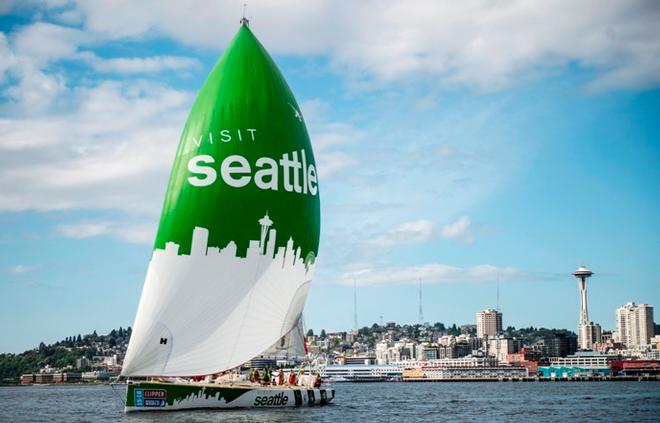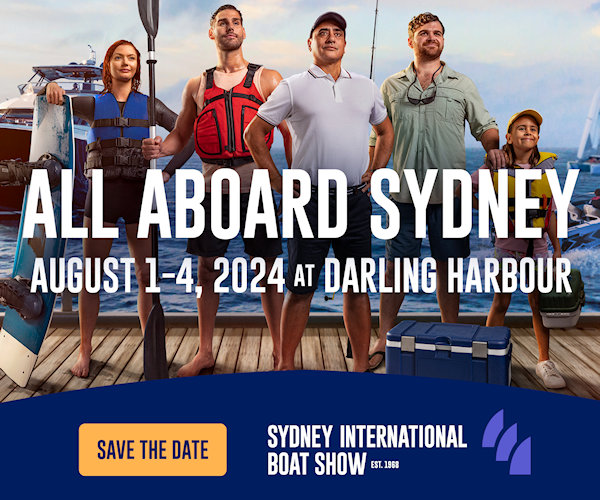A Q&A with Sir Robin Knox-Johnston on the Clipper Race’s Seattle visit
by David Schmidt, Sail-World USA Editor on 10 Apr 2017

Seattle returns as host and partner in Clipper Round the World Yacht Race Clipper Ventures


Some backstory. The Clipper Round the World Yacht Race operates on a model where a professional (and race-selected) skipper guides a team of paying, non-professional sailors around the world, via a series of planned stopovers, aboard one of twelve identical, 70-foot offshore steeds, whist simultaneously fostering an onboard environment that’s geared towards learning the ropes of offshore sailing. Each team decides how seriously they take the competition, with some teams aiming to top the podium steps at each stopover city, and other teams opting to focus more on learning different skillsets.
Irrespective of each team’s small-group objectives, all sailors also rotate through different non-sailing jobs-for example food preparation or vessel housekeeping-that are equally as critical as proper sail trim and navigation when it comes to the event’s big-picture goal of team-building, educating and crossing oceans.
While some sailors elect to do the entire circumnavigation, others opt to instead sail one (or several) individual legs, depending on their budget, free time and job/family commitments back ashore. Irrespective of passage length, however, all Clipper Race sailors that I have met over the years have all been really focused on learning to become solid bluewater sailors. Additionally, all sailors who are participating in the Clipper Round the World Yacht Race must also complete a comprehensive training program, prior to setting sail with the event.
On June 25, 2015, the Clipper Race announced that they would visit my hometown of Seattle, Washington, situated in the northwest corner of the US of A. Just under a year later the fleet arrived in the Emerald City, bruised and battered from a storm-blown passage from Qingdao, China that involved some significant weather (not to mention vessel breakage, including snapped bowsprits and even an entire steering station that got destroyed by an off-kilter wave), but all were significantly more experienced sailors upon their Seattle landfall than they were just a few weeks prior, when the leg’s starting guns fired off of Qingdao.
The Clipper Round the World Yacht Race recently announced that the 2017/2018 edition of the race will again visit Seattle (April of 2018), and I caught up with Sir Robin Knox-Johnston, who continues to actively serve as the race’s chairman, via email, to learn more about this exciting news.
From the race’s perspective, what were the best aspects of the event's 2016 visit to Seattle?
The visit to Seattle was simply wonderful and there were many highlights. From the warm reception we received from everyone we came into contact with, to the events that were organized, which impressed everyone that visited, from crew to supporters and race partners, it really showcased the city as a place to visit and do business with.
That said, I’m sure skipper Huw Fernie’s first pitch at the Mariners game would go down as one of the most special moments for him and the team! [Editor’s Note: Fernie was skipper of the yacht Visit Seattle during the event’s 2015/2016 edition.]
Can you give me an idea as to the kind of community reception you and the race received in Seattle? Did it seem as though the local community was really interested in the race?
The people of Seattle were incredibly welcoming, from the boating community to local businesses and people who had heard we were coming and wanted to find out more, the city opened its arms wide and it was greatly received.
Seattle’s maritime history and adventurous spirit goes hand in hand with the Clipper Race and you could really sense that with the interest and support we experienced, not just in Seattle itself but as the fleet was racing around the world. It was fantastic.
I know that the Clipper Race was offering rides to prospective future sailors during the Seattle stopover—has the Seattle visit lead to an uptick in the number of American and Canadian sailors who are participating in the race this time?
The response has been great, like our race crew the city and people have a great sense of adventure and we currently have 15 people from the area have signed up to take part in the 2017-18 edition. To give you some perspective, we had two crew [members] from the region in the last race so that is a huge uptake. Some are seasoned sailors around Washington [State] and others complete novices, that’s the great thing about the race, it brings people from all experiences together to work as a team and learn new skills whilst taking on Mother Nature.
The number-one aim of the Clipper Race is to encourage more people around the world to take up ocean racing, so Seattle has really proved itself worthy of the challenge.
From a logistical perspective, how did it work to end racing at the western edge of the Strait of Juan de Fuca and then motor sail in and out of Seattle? Obviously our winds are fickle (I’m being kind…), but could you see the teams racing in and out of the city this time? If not, is it because of all of the commercial shipping, or is it because you guys are worried about Puget Sound’s notoriously light airs?
The Race Start and Finish worked well and after nearly four weeks racing at sea in the North Pacific Ocean, allowed the crews some much needed rest on the approach to the Port of Seattle. We are always reviewing our course instructions for each race based on feedback and experience learned.
Given the numerous nationalities that are involved in the race as sailors, plus the Trump Administration’s new 'border-security initiatives”, are you at all concerned that U.S. Border Patrol might cause problems for the race when the sailors make landfall in the USA?
The Clipper Race is an inclusive event with more than 40 different nationalities represented. Our crew have not had any issue with U.S. boarder – security initiatives to date, and we have always had a great relationship with U.S. Border Patrol when the race has visited the U.S. in previous editions. The race and its crew received one of the warmest welcomes and support from the residents of Seattle when it visited in 2016 and we know that the city will open its arms wide to us once again and we are very much looking forward to returning.
Aesthetically, is it fair to say that Seattle’s optics of snow-and glacier-covered peaks offer a big visual departure from the other cities that you visit? What about culturally?
Seattle is a beautiful city and certainly has its finger on the pulse, pushing the boundaries in business and culture. Home to many independent micro-businesses and some of the world’s biggest corporations, it has global reach as a place to do business, live and visit.
Also its incredible natural surroundings of forests, mountain landscape and water make it a particularly impressive sight for the crew and a great way to be welcomed back to land after a month battling the North Pacific. Leaving again is hard but I expect many crew will return after such a positive experience.
Anything else about the Clipper Race’s relationship with Seattle and/or the USA that you’d like to add, for there record?
We very much look forward to returning and building our relationship with the city of Seattle and its people. It has got off to a fantastic start and will be a highly anticipated port in our race calendar.
If you want to link to this article then please use this URL: www.sail-world.com/152886